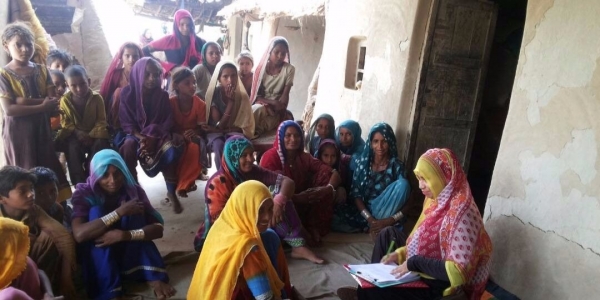Drought, flood and decrease in average rainfall are severely impacting Mirpur Khas in Sindh province. This has resulted in several challenges in the agricultural sector. Ghamz E Ali Siyal, Mohsin Ali Kazmi and Benazir Khumbhar trace the impacts of El Nino in the district.
El Niño is a natural phenomenon involving fluctuation of ocean temperatures in the Central and Eastern Pacific, accompanied with changes in atmosphere. This phenomenon can lead to heavy rains, floods and droughts and so on, and is responsible for increasing hunger as well. The major reason for the occurrence of El Niño is changes of trade winds, and its impact is felt across the world. Evidences of these and its impact can be traced in Pakistan as well.
In Pakistan, El Niño has negatively affected the summer monsoons. Such shifts in monsoon are also found in Khyber Pakhtunkhwa and Kashmir. While the Pakistan Meteorological Department, regularly predicts the impact that El Niño will have, the evidence of the same can also be found throughout country from 1986 to 2017.
Farmers’ responses in a baseline survey, conducted by Sustainable Development Policy Institute (SDPI) in August 2017 and funded by National Rural Support Program (NRSP), confirm the impact of El Niño in Mirpur Khas district, Sindh province, Pakistan. This survey, which was based on semi-structured questionnaire, focus group discussions and key informant interviews, traces the impact of El Niño on the agriculture sector (including crops, forests, orchards and livestock). The four union councils (UCs) in Mirpur Khas where the survey was conducted were Doulatpur, Kak, Kheerao and Chitori. All four UCs have similar socio-demographic conditions.

There are numerous crop varieties produced in both seasons and there is also trend of intercropping when orchard farming. The participation of women is high not only in the fields but also in livestock care and management.
In Mirpur Khas wheat and sugarcane are the major crops in the Rabi seasons. Minor crops include onion, spinach (saag), ladies finger (also known as Abelmoschus Esculentus), tomatoes and jantar (fodder for livestock). During the Kharif season, farmers mainly produce cotton. Orchard farming was not common in aforementioned UCs, and the average output produced was at 6,250 kg per season. The trend of intercropping was common for farmers producing fodder and sugarcane during orchard farming.
Due to El Niño there was a decrease in rainfall, which remained below average, in last two years during both summer and winter seasons. However, there were rising incidents of floods, droughts and heat stress along with increase in temperatures, irregular rainfall and uncertainty with regards to prediction of weather conditions.
Drought has not only adversely affected farmers, crops, livestock and orchards. Due to drought, production and quality of orchards and crops has decreased. There has been an increase of pest attack as well as pesticide use and decrease in the use of fertilizers. There has been an increase in diseases and death of livestock, alongside decrease in availability of fodder which has resulted in increase in prices due to mismatch in supply and demand. Storing fodder, drilling new wells or fetching water from nearby tube wells, shifting to other grazing areas in nearby towns, vaccination for viral diseases, selling livestock or permanently migrating livestock to other areas are common strategies in the management of livestock. It was found that due to drought people from neighbouring tehsils and districts had moved their livestock to Mirpur Khas for rearing. This increased the pressure on pastures in Mirpur Khas as well as the risk of viral diseases in animals.

Another outcome of El Niño was increasing flood incidences since last 10 years. Due to this there was destruction of crops, disease among or death of livestock, shortage of food, water contamination, prevalence of water-borne disease, damage to settlements and decrease of cost for watering land.
Livestock disease, crop disease, livestock death, food insecurity, shortage of water for livestock and heat stress also affected farmers. The risk mitigation strategies adopted by farmers against natural disasters was the accumulation of livestock and other assets, internal migration, paying attention to weather forecasts or early warnings, prayers or ceremonies, seeking alternate income and shifting livestock to their relatives living in other areas. However, early warning systems were not considered effective as while they provided alerts about the disaster they did not give information on long-term coping strategies. The farmers also required information on rainfall at least two weeks ahead of any disaster so that they could draw up a coping plan.
In conclusion, on the basis of the impacts discussed above here are few steps or initiatives that can possibly mitigate the impact of El Niño the people of Mirpur Khas. First, coping strategies and risk planning through community driven efforts should be developed. Second, there is a dire need for improving orchards by planting berry and sapodilla in saline affected farms. Similarly, sindhri, chanusa and roto varieties of mangoes should be planted in drought affected farms. Finally, the government should launch incentive-based schemes to support reforestation of trees.
This article gives the views of the author, and not the position of the South Asia @ LSE blog, nor of the London School of Economics. Please read our comments policy before posting.
About The Authors
Ghamz E Ali Siyal is Research Assistant at Sustainable Development Policy Institute (SDPI).
Mohsin Ali Kazmi, Senior Data Analyst at SDPI.
Benazir Khumbhar, Capacity Building Officer at National Rural Support Program (NRSP).







